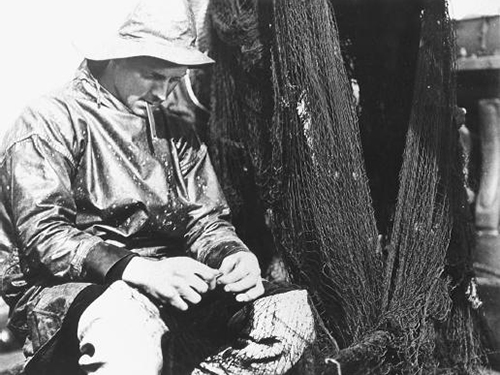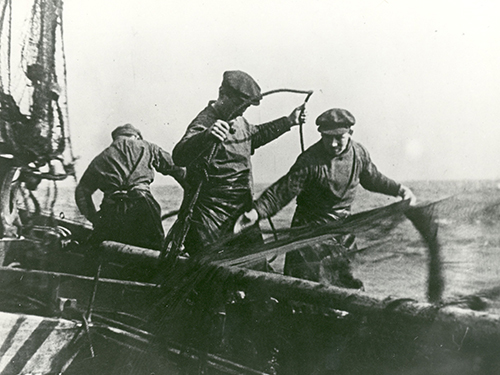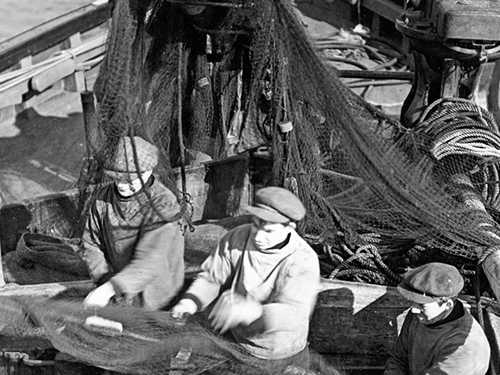Drifters

John Grierson (1898-1972), Scottish documentary maker, producer and film critic, was the founder of the British Documentary Movement, which had a tremendous influence on British film culture and the international documentary cinema altogether.
In the twenties Grierson is one of the first to see cinema not as a form of entertainment but as a social-political weapon, as a socially constructive force, as poetry. In a 1927 article on Robert J. Flaherty’s Moana (1926), he is the first to use the term documentary referring to cinema. The text featured here is about his first film, Drifters, a 1929 documentary on herring fishing on the Shetland Islands.
During his whole life Grierson is important to British and international cinema. He is said to be responsible for distributing Eisenstein’s Bronenosets Potemkin [Battleship Potemkin] (1925) in the United States, where he is studying until 1927. After completing his degree in moral philosophy he studies the psychology of propaganda and mass communication at the University of Chicago. He meets the journalist Walter Lippmann and follows him in denouncing the erosion of democracy. People could never understand all that needs to be understood about society in order to effectively participate in democracy. He sees in cinema a pedagogic function: to simplify and dramatize complex issues essential to all of society, in view of enhancing participation and tackling political apathy. Grierson says not to be interested in film as art form but rather as a means to an end, as propaganda. There is nevertheless a fiery call for a certain craftsmanship issuing from this text, a call for finding new forms to show ordinary people to ordinary people. Before, the lower classes in British cinema had never been able to escape the comical poetics in which bourgeois filmmaking had entrapped them. Funny gardeners and taxi drivers, horny maids, etc. Moreover, under Grierson there is room for experiment with cinema’s newest element: sound. Whereas classical film takes back a few steps in these first years of the sound film, the British Documentary Movement is doing pioneer’s work epitomizing in the collaboration between the duo Harry Watt and Basil Wright, the poet W.H. Auden and composer Benjamin Britten for their film Night Mail from 1936.
Grierson only directs two films of which Drifters is most well known and vastly popular with the crowds. After that he focuses on producing, distributing and writing about films. He makes it possible for filmmakers to work and even get paid for it, which for the young Joris Ivens is an unprecedented luxury. The founding of the British Documentary Movement is made possible due to the influence Grierson can exert from his newly acquired position in the Empire Marketing Board, the state organization where he has succeeded in convincing the right people of the bright future of cinema and of giving him control over his own department. Grierson is a pragmatist, a positivist who believes in the instrumentalizing of cinema in the struggle to create a more just society. “I look on cinema as a pulpit, and use it as a propagandist.”
It’s hard to ignore the often very paternalistic tone in his texts. He considers cinema to be a tool for a patriotic elite having to educate the people. This is less the case in this particular text, which can be read in a number of fashions, not in the least as an inspiring call for a cinephile culture, or as a love letter to life, expressed in writing reminiscent more of the poetry of cinema than that of literature. He wants films to be directed towards the existing world, for people to recognize themselves on the screen, for the beauty of the ‘original’ world to be shown: film as creative treatment of actuality. In his essay ‘First Principles of Documentary’ (1932) he states that the full potential of cinema resides within the observing of the original actor and the original scene.
Documentary film was relatively young, discourse on documentary even younger. However, there emanates from this text an enthusiasm for the new that could be heard in a lot of places back then: an energetic humanism seeking new forms, fuelled by the rise of new technologies and a newfound audacity; a conviction that the world could be made a better place, albeit issuing from this treacherous, volatile propagandistic discourse that would manifest itself later in very different, well-known shapes. This was a discourse on cinema that could be activated under anyone’s flag, much like how the camera itself records anything that is put in front of it. But the camera had been liberated, first attempts were made to reject early dogmas. Cinema could now wander into the real world. Apart from the love letter I read here, this text is also a historical document attesting to a language and energy native to the ideological struggle of the interwar period, attesting also, to the turbulent youth of cinema.
Hannes Verhoustraete

Drifters
Drifters is about the sea and about fishermen, and there is not a Piccadilly actor in the piece. The men do their own acting, and the sea does its – and if the result does not bear out the 107th psalm, it is my fault. Men at their labour are the salt of the earth; the sea is a bigger actor than Jannings of Nitikin or any of them; and if you can tell me a story more plainly dramatic than the gathering of the ships for the herring season, the going out, the shooting at evening, the long drift in the night, the hauling of nets by infinite agony of shoulder muscle in the teeth of a storm, the drive home against a head sea, and (for finale) the frenzy of a market in which said agonies are sold at ten shillings a thousand, and iced, salted and barrelled for an unwitting world – if you can tell me a story with a better crescendo in energies, images, atmospherics and all that make up the sum and substance of cinema, I promise you I shall make my next film of it forthwith.
But, of course, making a film is not just the simple matter of feeling the size of the material. If that were so every fool who fusses over a nondescript sunset, or bares his solar plexus to the salt sea waves on his summer holiday, would be an artist. I do not claim the brave word, though I would like to, but I think I know what it mostly means. It has very little to do with nondescript enthusiasm, and a great deal to do with a job of work.
In art, as in everything else, the gods are with the big battalions. You march on your subject with a whole regiment of energies: you surround it, your break in here, break in there, and let loose all the shell and shrapnel you can (by infinite pushing of your inadequate noddle) lay hands on. Out of the labour something comes. All you have to do then is to seize what you want. If you have really and truly got inside, you will have plenty – of whatever it is – to choose from.
So in this rather solid adventure of the herring fishery I did what I could to get inside the subject. I had spent a year or two of my life wandering about on the deep-sea fishing-boats, and that was an initial advantage. I knew what they felt like. Among other things they had developed in me a certain superior horsemanship, which was proof against all bronco-buckings, side-steppings and rollings whatsoever. I mention this because the limiting factor in all sea films is the stomach of the director and his cameramen. It is a super fact, beyond all art and non-art. Of my cameramen one also was an ex-seaman. The other, for all his bravery, was mostly unconscious.
In this matter I was altogether to blame. What I know of cinema I have learned partly from the Russians, partly from the American westerns, and partly from Flaherty, of Nanook. The westerns give you some notions of the energies. The Russians give you the energies and the intimacies both. And Flaherty is a poet.
The net effect of this cinematic upbringing was to make me want a storm: a real storm, an intimate storm, and if possible a rather noble storm. I waited in Lowestoft for weeks till the gale sign went up, and I got it. So did the cameramen. The wild Arabian breeze of the drifter’s bilges did not help matters.
Taking the film as a whole I got the essentials of what I wanted. I got the most beautiful fishing-village in the world – I found it in the Shetlands – for a starting point. I staged my march to the sea, the preparations, the procession out. I ran in detail of furnace and engine-room for image of force, and seas over a headland for image of the open. I took the ships out and cast the nets in detail: as to the rope over the cradle, the boy below, the men on deck against the sea; as to the rhythm of the heaving, the run on the rollers, the knotted haul of each float and net; as to the day and approaching night; as to the monotony of long labour. Two miles of nets to a ship: I threw them in a flood of repetition against a darkening sky.
The life of Natural cinema is in this massing of detail, in this massing of all the rhythmic energies that contribute to the blazing fact of the matter. Men and the energies of men, things and the functions of things, horizons and the poetics of horizons: these are the essential materials. And one must never grow so drunk with the energies and the functions as to forget the poetics.
I had prepared against that as best as I knew how. Image for this, image for that. For the settling of darkness, not darkness itself, but flocks of birds silhouetted against the sky flying hard into the camera: repeated and repeated. For the long drift in the night, not the ship, not the sea itself, but the dark mystery of the underwater. I made the night scene a sequence of rushing shoals and contorting congers. For the dawn, not a bleary fuss against the sky (which in cinema is nothing) but a winding slow-rolling movement into the light. Then a bell-buoy. Then a Dutch lugger rolling heavily into the light. Three images in a row.
You can never have your images too great, and I think there are none of us poets enough to make cinema properly. It is in the end a question of suggesting things, and all the example of Shakespearian metaphor is there to tell you how short we stand of the profundities.
The most solid scene, I would say, was the spectacle of the hauling. Camera and cameraman were lashed on top of the wheelhouse, and the nets came up through the heavy sea in great drifts of silver. We got at it from every angle we could and shot it inside out with the hand camera; and, put together, it made a brave enough show. But even then, the fact of the matter, however detailed, however orchestrated, was not enough. This business of horizons had to be faced over again. By fortune a whale came alongside to clean the nets, and I used it for more than a whale. I used it for a ponderous symbol of all that tumbled and laboured on that wild morning. It adds something, but it is possible that something else, had I but felt it properly, would have carried the scene still further to that horizon I speak of. Images, images – details and aspects of things that lift a world of fact to beauty and bravery – no doubt half a hundred passed under my nose, and I did not see them.
So through the procession into harbour, and the scenes in the market place at Yarmouth – fact joined to fact and detail to detail. But here, of course, because of the size and variety of the scene, rather greater possibilities in the matter of orchestration. The gathering procession of buyers and sellers on the quayside, the procession of ships through the harbour mouth: the two processions interwoven. The selling itself, the unloading, the carrying: mouth work and shoulder work interwoven, made complementary to each other, opposed to each other as your fancy takes you. Rivers of fish, being slid into a ship’s hold, cartfuls of baskets, girls gutting, barrels being rolled: all the complex detail of porterage and export dissolved into each other, run one on top of the other, to set them marching. It is the procession of results. Cranes and ships and railway trains – or their impressionistic equivalents – complete it.
The problem of images does not arise so plainly here, for cinematic processions, if you bring them off, are solid affairs that carry their own banners. Two however, I did try. As the labour of the sea turned to the labour of the land, I carried forward a wave theme. It is played heavily for accompaniment as the ships ride in; but as life on the quayside takes charge of the picture, it is diminished in strength till it vanished altogether. Through breaking waves the buyers and sellers go to their business. Count that, if you will, for an image of opposition. It is a far cry from the simple and solid labour of the sea to the nepman haggling of the market place.
The last was of similar type. As the catch was being bowed and barrelled I thought I would like to say that what was really being boxed and barrelled was the labour of men. So as the herring were shovelled in, and the ice laid on, and the hammer raised to complete the job, I slid back for a flash or two to the storm and the hauling. The hammer is raised on mere fish: it comes down on dripping oilskins and a tumbling sea. This notion I kept repeating in flashes through the procession of barrels and the final procession of railway truck. The barrels of the dead pass for a second into the living swirl of a herring shoal, in and out again; the smoke in a tunnel dissolves for a moment into the tautened wrist of a fisherman at the net-rope.
I cannot tell you what the result of it all is. Notions are notions and pictures are pictures, and no knowledge of cinematic anatomy can guarantee that extra something, which is the breath of life to a picture. If I raise this matter of images it is rather to give you some idea of how the movie mind works. It has to feel its way through the appearances of things, choosing, discarding and choosing again, seeking always those more significant appearances, which are like yeast to the plain dough of the context. Sometimes they are there for the taking; as often as not you have to make a journey into a far country to find them. That, however, is no more difficult for cinema than for poetry. The camera is by instinct, if not by training, a wanderer.

Originally published in The Clarion, October 1929.
Sources for the introduction:
Grierson (Roger Blais, 1973)
John Grierson, Grierson on Documentary, edited by Forsyth Hardy (London: Faber and Faber, 1979)
Forsyth Hardy, John Grierson: A Documentary Biography (London: Faber and Faber, 1979)
Images (1), (2) and (3) from Drifters (John Grierson, 1929)

